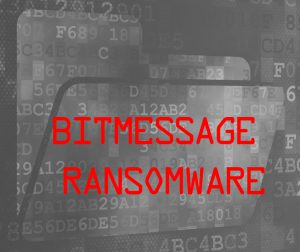 Bleep, .1999, .0x0, .fu*k – these are the file extensions used by the nasty Bitmessage ransomware virus that encrypts the files on the computers it infects and asks 2,5 BTC to decrypt them. After encryption, the files become unable to be opened because they are encoded with a very powerful AES-256 encryption algorithm. Users who have been infected with the virus are strongly advised not to pay any ransom money and wait for a decrypter to be released. In the meantime, you should remove the ransomware using the instructions in this article, and you may try our alternative suggestions to restore your data.
Bleep, .1999, .0x0, .fu*k – these are the file extensions used by the nasty Bitmessage ransomware virus that encrypts the files on the computers it infects and asks 2,5 BTC to decrypt them. After encryption, the files become unable to be opened because they are encoded with a very powerful AES-256 encryption algorithm. Users who have been infected with the virus are strongly advised not to pay any ransom money and wait for a decrypter to be released. In the meantime, you should remove the ransomware using the instructions in this article, and you may try our alternative suggestions to restore your data.

Threat Summary
| Name | Bitmessage Virus |
| Type | Ransomware |
| Short Description | The ransomware encrypts files with the AES-256 cipher and asks a ransom for decryption. |
| Symptoms | Files are encrypted and become inaccessible. A ransom note with instructions for paying the ransom shows as several txt files. |
| Distribution Method | Spam Emails, Email Attachments, File Sharing Networks. |
| Detection Tool |
See If Your System Has Been Affected by malware
Download
Malware Removal Tool
|
| User Experience | Join our forum to Discuss Bitmessage Ransomware. |

Bitmessage Ransomware – How Is It Spread
To infect users, Bitmessage has been reported to use spam e-mail messages to distribute its payload. This can happen either via a Malicious URL or via a malicious e-mail attachment. Such can be featured in e-mails whose topics resemble services which are widely used, for example:
- “Your FedEx Delivery.”
- “Confirm your order.”
- “Your receipt.”
- “PayPal: Your Account Has Been Suspended”
- “Your BestBuy order has been delivered.”
Such e-mails may either contain malicious links or attachments which can contain:
- Malicious JavaScript.
- ExploitKits.
- Obfuscated executables.
Users are also strongly advised against clicking on e-mails, which resemble the following sample:

Bitmessage Ransomware In Detail
Upon execution on the infected computer, Bitmessage may create a malicious file in one of the following Windows folders:
- %AppData%
- %Roaming%
- %User’s Profile%
- %Temp%
- %Local%
After creating the malicious file, it may be executed and start scanning for the following files to encrypt them. The ransomware has been reported to look for files with the following file extensions to encrypt them:
→ .113 .1cd .3dm .3ds .3fr .3g2 .3gp .3pr .73b .7z .a3d .ab4 .abf .abk .ac2 .accdb .accde .accdr .accdt .acr .adb .aep .agd1 .ach .ai .ait .al .apj .apk .ark .arw .as4 .asf .asm .asp .asset .asvx .asx .ate .ati .avi .awg .azw .azw4 .b1 .bac .back .backup .backupdb .bak .bakx .bar .bay .bb .bc6 .bc7 .bck .bcm .bdb .bgt .big .bik .bin .bkf .bkp .blend .blob .bpw .bsa .c .cab .cas .cb7 .cbr .cbt .ccd .cdf .cdr .cdr3 .cdr4 .cdr5 .cdr6 .cdrw .cdx .ce1 .ce2 .cer .cf .cfp .cfr .cgm .cib .cls .cmt .con .cpi .cpp .cpt .cr2 .craw .crt .crw .cs .csh .csl .css .csv .ctb .d3dbsp .dac .das .dat .data .db .db0 .db3 .dba .dbf .dc2 .dc3 .dcr .dcs .ddrw .dds .der .des .desc .design .dgb .dgc .dicom .divx .djvu .dmg .dmp .dng .doc .docm .docx .dot .dotm .dotx .drf .drw .dt .dta .dtaus .dtd .dwfx .dwg .dxb .dxf .dxg .edi .eml .emlx .epk .eps .epub .erbsql .erf .esm .exf .fb2 .fbf .fbk .fbw .fbx .fdb .ffd .fff .fh .fhd .fla .flac .flv .forge .fos .fpk .fpx .fsh .fxg .gbk .gdb .gho .gif .gpx .gray .grey .gros .gry .h .hbk .hkdb .hkx .hplg .hpp .htm .html .hvpl .hxi .hxq .hxr .hxs .hxw .chi .chm .chq .chw .ibank .ibd .ibz .icxs .idx .iff .img .inc .incpas .iso .itdb .itl .itm .iv2i .iwd .iwi .jar .java .jpe .jpeg .jpg .js .kc2 .kdb .kdbx .kdc .key .keystore .keystore .kf .kpdx .layout .lbf .ldf .lic .lit .litemod .lrf .ltx .lua .lvl .m .m2 .m2v .m3d .m3u .m4a .m4v .map .max .mcmeta .mdb .mdbackup .mdc .mddata .mdf .mds .mef .menu .mfw .mkv .mlx .mmw .mobi .model .moneywell .mos .mov .mp3 .mp4 .mpeg-1 .mpeg-2 .mpeg-4 .mpg .mpg .mpq .mpqge .mrw .mrwref .msg .myd .nbd .ncf .nd .ndd .nef .netcdf .nk2 .nop .nrw .ns2 .ns3 .ns4 .nsd .nsf .nsg .nsh .ntl .nwb .nx1 .nx2 .nyf .oab .obj .odb .odc .odf .odg .odm .odp .ods .odt .orf .ost .otg .oth .otp .ots .ott .p12 .p7b .p7c .pab .pak .pas .pat .pcd .pct .pdb .pdb .pdd .pdf .pef .pem .pfx .php .pkpass .pl .png .pot .potm .potx .ppam .pps .ppsm .ppsx .ppt .pptm .pptx .prf .prproj .ps .psafe3 .psd .psk .pst .ptx .pub .pwm .py .pz3 .qba .qbb .qbm .qbo .qbr .qbw .qbx .qby .qdf .qfx .qic .qif .qt .qvw .s3db .sav .sb .sbs .sd0 .sd1 .sda .sdf .sdxf .shtm .shtml .sid .sidd .sidn .sie .sis .sldasm .sldm .sldprt .sldx .slm .sln .sn1 .sna .snx .spf .sql .sqlite .sqlite3 .sqlitedb .sr2 .srf .srt .srw .st4 .st5 .st6 .st7 .st8 .stc .std .sti .stw .stx .sub .sum .suo .svg .swf .swm .sxc .sxd .sxg .sxi .sxm .sxw .t12 .t13 .tar .tax .tbl .tex .tga .tib .tis .tlg .trn .txt .upk .vcf .vdf .vfs0 .vob .vob .vpk .vpp_pc .vtf .w3x .wab .wallet .wav .wbb .wbcat .wdb .wif .wim .win .wma .wmo .wmv .wpd .wps .x3f .xar .xf .xla .xlam .xlk .xll .xlm .xlr .xls .xlsb .xlsk .xlsm .xlsx .xlt .xltm .xltx .xlw .xmi .xml .ycbcra .yuv .z .zip .ztmp
The encrypted files are unable to be opened, because their code is changed to an AES-256 enciphered one. This type of encryption is one of the strongest, and the only method to crack it quickly is to find a flaw in the virus itself.
The encrypted files have one of the following file extensions:
- .bleep
- .1999
- .0x0
- .fu*k
Encrypted files may look like this:
After encryption, Bitmessage ransomware adds the following files:
- FILESAREGONE.TXT – A ransom note with the demands by the cyber-criminals.
- READTHISNOW !!!. TXT – A ransom note with instructions about paying the ransom.
- IHAVEYOURSECRET.KEY – A file containing a private or a public AES key without which you cannot unlock your files.
- Secret.key, Secret.key2 – other .key files.
The ransom note feature in the FILESAREGONE.TXT is the following:
→ “Hello.
All your files have been encrypted using our extremely strong private key. There is no way to recover them without our assistance. If you want to get your files back, you must be ready to pay for them. If you are broke and poor, sorry, we cannot help you. If you are ready to pay, then get in touch with 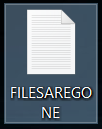
us using a secure and anonymous p2p messenger. We have to use a messenger, because standard emails get blocked quickly and if our email gets blocked your files will be lost forever.
Go to https://bitmessage.org/, download and run Bitmessage. Click Your Identities tab > then click New > then click OK (this will generate your personal address, you need to do this just once). Then click Send tab.
TO: {Unique ID}
SUBJECT: name of your PC or your IP address or both.
MESSAGE: Hi, I am ready to pay.
Click Send button.
You are done.
To get the fastest reply from us with all further instructions, please keep your Bitmessage running on the computer at all times, if possible, or as often as you can, because Bitmessage is a bit slow and it takes time to send and get messages. If you cooperate and follow the instructions, you will get all your files back intact and very, very soon. Thank you.”
The instructions in the READTHISNOW.txt file are the following:
→ “Hello.
All your files have been encrypted using our private key. There is no way to recover them without our assistance.
If you want to get your files back, you must be ready to pay for them. If you are ready to pay then follow the instructions: 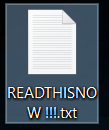
1) Create an archive (rar or zip) with 3 files inside: Secret.key + Secret.key2 (should be on your desktop) + Any encrypted file of a small size. It can be a .doc or .pdf or .xls or whatever you have. 5 mb max. Note that this file should have this extention: .0x0; please don’t put more than one file in the archive, one file is enough. If you can’t find Secret.key2, that’s OK. It will take just a little bit more time to restore your files, so you shouldn’t worry.
2) Upload this archive to any file sharing site. Dropbox, Google Drive, sendspace.com etc.
3) Go to https://bitmessage.org/ and download Bitmessage.
4) Run Bitmessage. Select ‘Your Identities’ tab. Then click New. Then click OK. Then select ‘Send’ tab.
TO: BM-%address% (this is our address)
SUBJECT: your PC name (Start -> Control Panel -> System)
MESSAGE: Link to the archive with three files in it. Then click ‘Send’.
You are done!
To get the fastest reply from us with all further instructions, please keep Bitmessage running on your computer all the time, if possible. If you cooperate and follow the instructions, you will get all your files back intact and very, very soon. Thank you.”
In addition to those, the ransomware may also modify the following registry key adding a setting for its malicious executable to run and encrypt files every time you boot Windows:
→ HKEY_LOCAL_MACHINE\Software\Microsoft\Windows\CurrentVersion\Run
Bitmessage ransomware may also delete the shadow copies of the infected computer, eliminating the file history if it is enabled. This is done by executing the following command:
→ vssadmin delete shadows /for={The targeted volume} /all
Not only this but unlike other ransomware viruses, this one uses a very particular contact service which includes messaging service, called Bitmessage which most likely uses encrypted communications. This Is a relatively new and interesting approach by cyber-criminals, and the number of viruses that have it has increased.

Remove Bitmessage Ransomware and Restore the Encrypted Files
To fully erase Bitmessage Ransomware from your computer, be sure to follow the step-by-step instructions below. They will help to deal effectively with the threat. If you are having issues removing this virus manually, we advise to automatically scan for and delete all its associated objects with an advanced anti-malware tool.
In addition to that, to try and restore your files, we have provided alternative solutions in step “3.Restore files encrypted by Bitmessage Virus” below. They may not be 100 percent effective, and you will most likely restore a small portion of your files, but it is a good alternative for until a decryptor is released. Make sure to follow this article for further updates about direct file decryption.
- Step 1
- Step 2
- Step 3
- Step 4
- Step 5
Step 1: Scan for Bitmessage Virus with SpyHunter Anti-Malware Tool



Ransomware Automatic Removal - Video Guide
Step 2: Uninstall Bitmessage Virus and related malware from Windows
Here is a method in few easy steps that should be able to uninstall most programs. No matter if you are using Windows 10, 8, 7, Vista or XP, those steps will get the job done. Dragging the program or its folder to the recycle bin can be a very bad decision. If you do that, bits and pieces of the program are left behind, and that can lead to unstable work of your PC, errors with the file type associations and other unpleasant activities. The proper way to get a program off your computer is to Uninstall it. To do that:


 Follow the instructions above and you will successfully delete most unwanted and malicious programs.
Follow the instructions above and you will successfully delete most unwanted and malicious programs.
Step 3: Clean any registries, created by Bitmessage Virus on your computer.
The usually targeted registries of Windows machines are the following:
- HKEY_LOCAL_MACHINE\Software\Microsoft\Windows\CurrentVersion\Run
- HKEY_CURRENT_USER\Software\Microsoft\Windows\CurrentVersion\Run
- HKEY_LOCAL_MACHINE\Software\Microsoft\Windows\CurrentVersion\RunOnce
- HKEY_CURRENT_USER\Software\Microsoft\Windows\CurrentVersion\RunOnce
You can access them by opening the Windows registry editor and deleting any values, created by Bitmessage Virus there. This can happen by following the steps underneath:


 Tip: To find a virus-created value, you can right-click on it and click "Modify" to see which file it is set to run. If this is the virus file location, remove the value.
Tip: To find a virus-created value, you can right-click on it and click "Modify" to see which file it is set to run. If this is the virus file location, remove the value.
Before starting "Step 4", please boot back into Normal mode, in case you are currently in Safe Mode.
This will enable you to install and use SpyHunter 5 successfully.
Step 4: Boot Your PC In Safe Mode to isolate and remove Bitmessage Virus





Step 5: Try to Restore Files Encrypted by Bitmessage Virus.
Method 1: Use STOP Decrypter by Emsisoft.
Not all variants of this ransomware can be decrypted for free, but we have added the decryptor used by researchers that is often updated with the variants which become eventually decrypted. You can try and decrypt your files using the instructions below, but if they do not work, then unfortunately your variant of the ransomware virus is not decryptable.
Follow the instructions below to use the Emsisoft decrypter and decrypt your files for free. You can download the Emsisoft decryption tool linked here and then follow the steps provided below:
1 Right-click on the decrypter and click on Run as Administrator as shown below:

2. Agree with the license terms:

3. Click on "Add Folder" and then add the folders where you want files decrypted as shown underneath:

4. Click on "Decrypt" and wait for your files to be decoded.

Note: Credit for the decryptor goes to Emsisoft researchers who have made the breakthrough with this virus.
Method 2: Use data recovery software
Ransomware infections and Bitmessage Virus aim to encrypt your files using an encryption algorithm which may be very difficult to decrypt. This is why we have suggested a data recovery method that may help you go around direct decryption and try to restore your files. Bear in mind that this method may not be 100% effective but may also help you a little or a lot in different situations.
Simply click on the link and on the website menus on the top, choose Data Recovery - Data Recovery Wizard for Windows or Mac (depending on your OS), and then download and run the tool.
Bitmessage Virus-FAQ
What is Bitmessage Virus Ransomware?
Bitmessage Virus is a ransomware infection - the malicious software that enters your computer silently and blocks either access to the computer itself or encrypt your files.
Many ransomware viruses use sophisticated encryption algorithms to make your files inaccessible. The goal of ransomware infections is to demand that you pay a ransom payment to get access to your files back.
What Does Bitmessage Virus Ransomware Do?
Ransomware in general is a malicious software that is designed to block access to your computer or files until a ransom is paid.
Ransomware viruses can also damage your system, corrupt data and delete files, resulting in the permanent loss of important files.
How Does Bitmessage Virus Infect?
Via several ways.Bitmessage Virus Ransomware infects computers by being sent via phishing emails, containing virus attachment. This attachment is usually masked as an important document, like an invoice, bank document or even a plane ticket and it looks very convincing to users.
Another way you may become a victim of Bitmessage Virus is if you download a fake installer, crack or patch from a low reputation website or if you click on a virus link. Many users report getting a ransomware infection by downloading torrents.
How to Open .Bitmessage Virus files?
You can't without a decryptor. At this point, the .Bitmessage Virus files are encrypted. You can only open them once they are decrypted using a specific decryption key for the particular algorithm.
What to Do If a Decryptor Does Not Work?
Do not panic, and backup the files. If a decryptor did not decrypt your .Bitmessage Virus files successfully, then do not despair, because this virus is still new.
Can I Restore ".Bitmessage Virus" Files?
Yes, sometimes files can be restored. We have suggested several file recovery methods that could work if you want to restore .Bitmessage Virus files.
These methods are in no way 100% guaranteed that you will be able to get your files back. But if you have a backup, your chances of success are much greater.
How To Get Rid of Bitmessage Virus Virus?
The safest way and the most efficient one for the removal of this ransomware infection is the use a professional anti-malware program.
It will scan for and locate Bitmessage Virus ransomware and then remove it without causing any additional harm to your important .Bitmessage Virus files.
Can I Report Ransomware to Authorities?
In case your computer got infected with a ransomware infection, you can report it to the local Police departments. It can help authorities worldwide track and determine the perpetrators behind the virus that has infected your computer.
Below, we have prepared a list with government websites, where you can file a report in case you are a victim of a cybercrime:
Cyber-security authorities, responsible for handling ransomware attack reports in different regions all over the world:
Germany - Offizielles Portal der deutschen Polizei
United States - IC3 Internet Crime Complaint Centre
United Kingdom - Action Fraud Police
France - Ministère de l'Intérieur
Italy - Polizia Di Stato
Spain - Policía Nacional
Netherlands - Politie
Poland - Policja
Portugal - Polícia Judiciária
Greece - Cyber Crime Unit (Hellenic Police)
India - Mumbai Police - CyberCrime Investigation Cell
Australia - Australian High Tech Crime Center
Reports may be responded to in different timeframes, depending on your local authorities.
Can You Stop Ransomware from Encrypting Your Files?
Yes, you can prevent ransomware. The best way to do this is to ensure your computer system is updated with the latest security patches, use a reputable anti-malware program and firewall, backup your important files frequently, and avoid clicking on malicious links or downloading unknown files.
Can Bitmessage Virus Ransomware Steal Your Data?
Yes, in most cases ransomware will steal your information. It is a form of malware that steals data from a user's computer, encrypts it, and then demands a ransom in order to decrypt it.
In many cases, the malware authors or attackers will threaten to delete the data or publish it online unless the ransom is paid.
Can Ransomware Infect WiFi?
Yes, ransomware can infect WiFi networks, as malicious actors can use it to gain control of the network, steal confidential data, and lock out users. If a ransomware attack is successful, it could lead to a loss of service and/or data, and in some cases, financial losses.
Should I Pay Ransomware?
No, you should not pay ransomware extortionists. Paying them only encourages criminals and does not guarantee that the files or data will be restored. The better approach is to have a secure backup of important data and be vigilant about security in the first place.
What Happens If I Don't Pay Ransom?
If you don't pay the ransom, the hackers may still have access to your computer, data, or files and may continue to threaten to expose or delete them, or even use them to commit cybercrimes. In some cases, they may even continue to demand additional ransom payments.
Can a Ransomware Attack Be Detected?
Yes, ransomware can be detected. Anti-malware software and other advanced security tools can detect ransomware and alert the user when it is present on a machine.
It is important to stay up-to-date on the latest security measures and to keep security software updated to ensure ransomware can be detected and prevented.
Do Ransomware Criminals Get Caught?
Yes, ransomware criminals do get caught. Law enforcement agencies, such as the FBI, Interpol and others have been successful in tracking down and prosecuting ransomware criminals in the US and other countries. As ransomware threats continue to increase, so does the enforcement activity.
About the Bitmessage Virus Research
The content we publish on SensorsTechForum.com, this Bitmessage Virus how-to removal guide included, is the outcome of extensive research, hard work and our team’s devotion to help you remove the specific malware and restore your encrypted files.
How did we conduct the research on this ransomware?
Our research is based on an independent investigation. We are in contact with independent security researchers, and as such, we receive daily updates on the latest malware and ransomware definitions.
Furthermore, the research behind the Bitmessage Virus ransomware threat is backed with VirusTotal and the NoMoreRansom project.
To better understand the ransomware threat, please refer to the following articles which provide knowledgeable details.
As a site that has been dedicated to providing free removal instructions for ransomware and malware since 2014, SensorsTechForum’s recommendation is to only pay attention to trustworthy sources.
How to recognize trustworthy sources:
- Always check "About Us" web page.
- Profile of the content creator.
- Make sure that real people are behind the site and not fake names and profiles.
- Verify Facebook, LinkedIn and Twitter personal profiles.














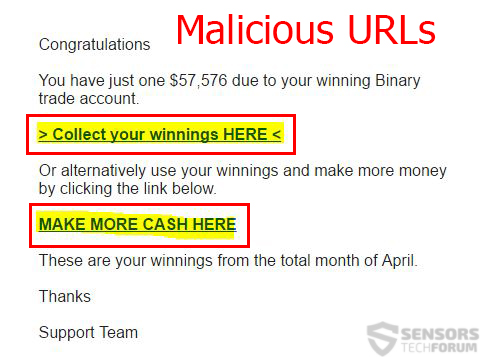
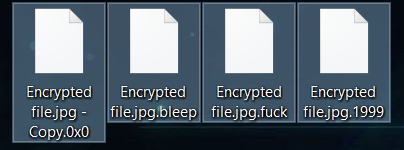

I think e-mails are the most common way for the Ransomwares to spread my system was hit by Petya Ransomware and I am sure that it came through an e-mail. So, is there any software that can detect a malicious e-mail.
Hello Sneha,
You can use spam blocking software and spam filters. Spam filters are designed to identify and detect spam, and prevent it from reaching your inbox. Make sure to add a spam filter to your email. Gmail users can refer to Google’s support page.
You can also consider installing an anti-ransomware tool: sensorstechforum.com/the-most-popular-free-anti-ransomware-tools
Hello,
Thanks for your help. It was useful to me.
hey pls give me strong solution
hi
i want to encrypted photo recover raas Encrypted Files recover pls help me